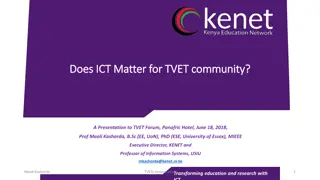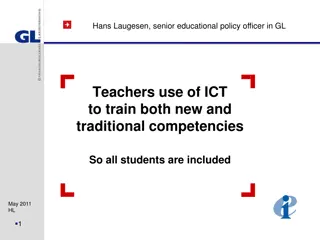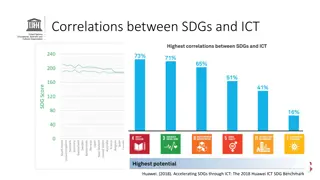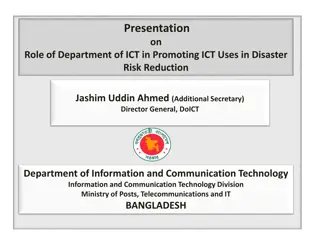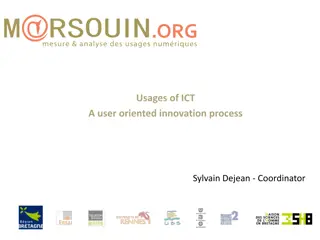Principles of Data Analysis and ICT in Postgraduate Studies at University of Nigeria
This lecture at the University of Nigeria, Nsukka, School of Postgraduate Studies focuses on the importance of ICT in data analysis, different data collection strategies, and the significance of using qualitative and quantitative data. The goals include creating awareness about ICT's role, refreshing students on data collection, emphasizing well-constructed instruments, and empowering students to ask relevant questions to data analysis experts. Both qualitative and quantitative data collection strategies are explored, with examples provided to illustrate their differences and importance.
Uploaded on Sep 28, 2024 | 1 Views
Download Presentation

Please find below an Image/Link to download the presentation.
The content on the website is provided AS IS for your information and personal use only. It may not be sold, licensed, or shared on other websites without obtaining consent from the author.If you encounter any issues during the download, it is possible that the publisher has removed the file from their server.
You are allowed to download the files provided on this website for personal or commercial use, subject to the condition that they are used lawfully. All files are the property of their respective owners.
The content on the website is provided AS IS for your information and personal use only. It may not be sold, licensed, or shared on other websites without obtaining consent from the author.
E N D
Presentation Transcript
UNIVERSITY OF NIGERIA, NSUKKA SCHOOL OF POSTGRADUATE STUDIES ICT AND PRINCIPLES OF DATA ANALYSIS PROF. UZOMA ODERA OKOYE University of Nigeria, Nsukka uzoma.okoye@unn.edu.ng 0806049031 Department of Social Work PGC 601
OUTLINE Goals and objectives Importance of ICT in data analysis Quantitative and qualitative data Popular analytical packages PGC 601
GOALS AND OBJECTIVES The goals and objectives of this lecture are as follows: To create a general awareness about the use and importance of ICT in data analysis To refresh the students mind on different forms of data collection strategies To provide information on different forms of software for analysing quantitative and qualitative data The re-emphasise the importance of well constructed and administered instruments To empower students to ask pointed questions to data analysis experts and crosscheck what was done for them. PGC 601
DATA COLLECTION STRATEGIES To have a good data to analyze you must first of all collect quality data In order to collect quality data, you must have a good instrument The two forms of data collection strategies are: Qualitative Quantitative PGC 601
QUALITATIVE STRATEGY QUALITATIVE strategy involves an exploratory approach and seeks to explain how and why a particular phenomenon, or programme, operates as it does in a particular context The goal of qualitative strategy is to develop hypotheses based on the observed meaning-making processes of individuals and groups Qualitative data presents as categorical measurement expressed not in terms of numbers, but rather by means of a natural language description Sometimes qualitative data can provide descriptive information that may corroborate some of the findings from the quantitative method Examples of qualitative instrument include interview or focus group discussion guide or schedule PGC 601
QUANTITATIVE STRATEGY It deals with measurable and quantifiable aspects of phenomenon under study. It focuses on to what extent? By how much? What relationship exists between factors? What causes particular processes or situations? The concern is on the collection and analysis of data in numeric form Data collected through qualitative means can be used to determine the size, distribution, and association of certain variables in a study population. How many? How often? and How significant? are important questions requiring fairly simple statistical techniques. Questionnaire and check list are examples. PGC 601
DATA COLLECTION SOFTWARES These computerised system for the collection and storage of qualitative and quantitative data in an electronic form. Popular ones are Google doc Open Data Kit Survey Monkey Teamscope KoboToolbox PGC 601
WHAT IS DATA ANALYSIS IN QUALITATIVE STRATEGY? Qualitative data analysis is a process that seeks to reduce and make sense of vast amounts of information, so that impressions that shed light on a research question can emerge. The information can consist of interview transcripts, documents, blogs, surveys, pictures, videos etc Qualitative data analysis typically revolves around the impressions and interpretations of key researchers. The first step is to transcribe the data using verbatim transcription. Then you go into data analysis which involves identifying key themes emerging from the data. PGC 601
POPULAR QUALITATIVE ANALYTICAL PACKAGES Nvivo ATLAS.ti , HubSpot, MAXQDA, Quirkos, Qualtrics, Raven's Eye PGC 601
ADVANTAGES OF USING DATA ANALYSIS SOFTWARE IN QUANTITATIVE STRATEGY Reduce/eliminate errors in calculation Data management, e.g., add variables & observations, recode variables, etc. Graphical utilities Multiple users can work with the same data file Faster, more efficient PGC 601
ADVANTAGES OF USING DATA ANALYSIS SOFTWARE IN QUALITATIVE STRATEGY The software gives you more control over your data and makes organization of data much easier. It makes it easier to find and compare data since all the data are in one single file. You can record and trace-back your analytical decisions by logging them into the program (memos) while coding. It helps you to be more reliable as a researcher, to learn from your successes and mistakes, and to be clear and transparent on analytical decisions. It helps you to still be in charge of the data since the interpretative work will still be done by you: the software facilitates your life but does not interpret things for you. PGC 601
GENERIC FEATURES OF NIVIVO Can operate in multiple languages Merge separate projects or use the structure of an existing project for a new one NVivo s workspace is based on Microsoft user interface guidelines, so it looks familiar Import documents in MS Word, PDF, rtf, even videos and audios. NVivo lets you gather all your material about a theme, idea or topic together through coding PGC 601
USING NIVIVO TO ANALYSE YOUR QUALITATIVE DATA STEP 1 - Review your research questions Ensure you have a clear research question. You may want to import them into NVivo for easy reference STEP 2 - Read a few transcripts and write summary memos. .. When you open a transcript, click on Memo Link in the Ribbon to create a linked memo to that transcript STEP 3 - Create a research journal and develop a coding strategy. ... Reflect on how they relate to your research questions and develop an initial broad coding strategy STEP 4 - Code for the broad topic areas Develop themes PGC 601
EXAMPLES OF A CODE PAGE PGC 601
WHAT IS DATA ANALYSIS IN QUANTITATIVE STRATEGY? Data analysis is the process of extracting information from data. It involves multiple stages including establishing a data set, preparing the data for processing, applying various statistical tools, identifying key findings and creating reports There are a variety of specific data analysis method, some of which include descriptive, inferential, predictive, casual etc PGC 601
POPULAR QUANTITATIVE ANALYTICAL PACKAGES Statistical Package for Social Sciences (SPSS), Epidemiological Information (Epi Info), Microsoft Excel STATA SAS PGC 601
GENERIC FEATURES OF SPSS Raw data are organized in tabular format with each observation having a row and each variable its own column (i.e., observation by attribute) Data, command, & output files are distinct and saved as such Menu or syntax can be used to create graphical displays Variables have to be identified in a certain format prior to analysis (most likely numeric, not string ) Extensive help menus PGC 601
USING SPSS TO ANALYZE YOUR DATA The first thing to do is to develop your questionnaire in such a way that it will be easy to code Also number your questionnaire serially before coding Why? For quality control and to make corrections easier The next thing to do is to develop value labels PGC 601
EXAMPLE OF A QUESTIONNAIRE Instruction:Please carefully read the questions below and provide a response to each question by ticking ( ) to your chosen option(s) from the alternatives provided. Where there are no options, you are free to indicate other responses as it applies to you. Section A: Socio-Demographic Information 1. Sex: (1) Male [ ] (2) Female [ 2. How old were you during your last birthday? ____________________________ ] 3. Marital status: (1) Single [ (4) Divorced [ 4. Occupation: (1) Farmer [ (4) Civil Servant [ ] (5) Student [ ], 5. Educational Status: (1) No formal education [ (3) Primary education non-completed [ ], (4) Secondary education completed[ ] (5) Secondary education non- completed [ ], (6) Tertiary education completed[ ], (7) Tertiary education non-completed [ ], (8) Don t know/No answer [ ] 6. Religion: (1) Catholic [ ], (2) Protestants [ ], (3) Pentecostal [ ], (4) Islam [ ], (5) African Traditional Religion [ ], (6) Others specify ____________________ ], ] (5) Widowed [ ]. ], (2) Married [ ], (3) Separated [ ], (2) Trader [ ], (3) Artisan [ ], (6) Unemployed [ ], (7) Others specify _______ ], (2) Primary education completed [ ], PGC 601
COMPLETED SPSS DATA PAGE PGC 601
QUESTIONS AND COMMENTS WHAT I HAVE LEARNT FROM THE WORKSHOP Want to share? PGC 601













